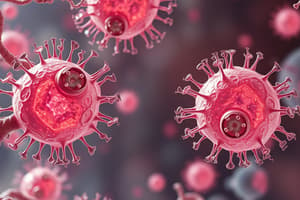Podcast
Questions and Answers
How many chromosomes does a normal cell in your body have?
How many chromosomes does a normal cell in your body have?
46 chromosomes (23 from mom and 23 from dad)
What are homologous chromosomes?
What are homologous chromosomes?
Chromosomes that contain genes for the same trait from each parent.
What is a chromatid?
What is a chromatid?
A single strand of a chromosome.
When are chromosomes visible in cells?
When are chromosomes visible in cells?
What is chromatin?
What is chromatin?
Match the following cell types with their chromosome counts:
Match the following cell types with their chromosome counts:
What is the main difference between Meiosis and Mitosis?
What is the main difference between Meiosis and Mitosis?
What are the two basic stages of the cellular lifecycle?
What are the two basic stages of the cellular lifecycle?
What occurs during interphase for both Meiosis and Mitosis?
What occurs during interphase for both Meiosis and Mitosis?
What happens during Meiosis Prophase I?
What happens during Meiosis Prophase I?
What is crossover in Meiosis?
What is crossover in Meiosis?
What happens during Telophase I of Meiosis?
What happens during Telophase I of Meiosis?
What occurs during Meiosis II?
What occurs during Meiosis II?
What happens during Anaphase I of Meiosis?
What happens during Anaphase I of Meiosis?
What is cytokinesis in Mitosis?
What is cytokinesis in Mitosis?
Flashcards are hidden until you start studying
Study Notes
Somatic Cells vs. Gametes
- Somatic cells in the human body contain 46 chromosomes, comprising 23 pairs from each parent.
- Gametes, or sex cells, have 23 chromosomes, which are haploid, meaning they contribute to fertilization, resulting in a zygote with 46 chromosomes.
Homologous Chromosomes
- Homologous chromosomes carry genes for the same traits, one from each parent, such as eye color.
Chromatids and Chromatin
- A chromatid is a single strand of a chromosome.
- Chromatin refers to genetic material within non-dividing cells, spread throughout the nucleus to facilitate gene expression for protein synthesis.
Meiosis vs. Mitosis
- Meiosis is exclusive to gamete production and reduces chromosome number from diploid (46) to haploid (23) through two division cycles.
- Mitosis results in two identical diploid daughter cells without reducing chromosome number.
Cellular Lifecycle Stages
- The two basic stages of the cellular lifecycle are Interphase followed by either Meiosis or Mitosis.
Interphase Process
- During Interphase, DNA is in chromatin form, and chromosomes replicate, resulting in 92 chromatids before cell division.
Meiosis Stages: Prophase I & Metaphase I
- In Prophase I, homologous chromosomes pair up to form tetrads, allowing for crossover where chromatids exchange genetic material.
- In Metaphase I, independent assortment occurs as homologous chromosomes line up randomly, enhancing genetic variation in offspring.
Crossover
- Crossover occurs during Prophase I, redistributing genetic material and increasing variation among potential offspring.
Meiosis - Telophase I
- Telophase I includes the reformation of nuclear envelopes and the formation of two haploid daughter cells with 23 chromosomes each.
Meiosis II
- In Meiosis II, daughter cells enter a second division cycle, resulting in four haploid gametes with only one chromatid per chromosome.
Meiosis - Anaphase I
- In Anaphase I, sister chromatids separate and are pulled to opposite poles of the cell by the mitotic spindle.
Cytokinesis in Mitosis
- Cytokinesis in mitosis involves the separation of the cytoplasm, producing two diploid daughter cells that are genetically identical.
Studying That Suits You
Use AI to generate personalized quizzes and flashcards to suit your learning preferences.



